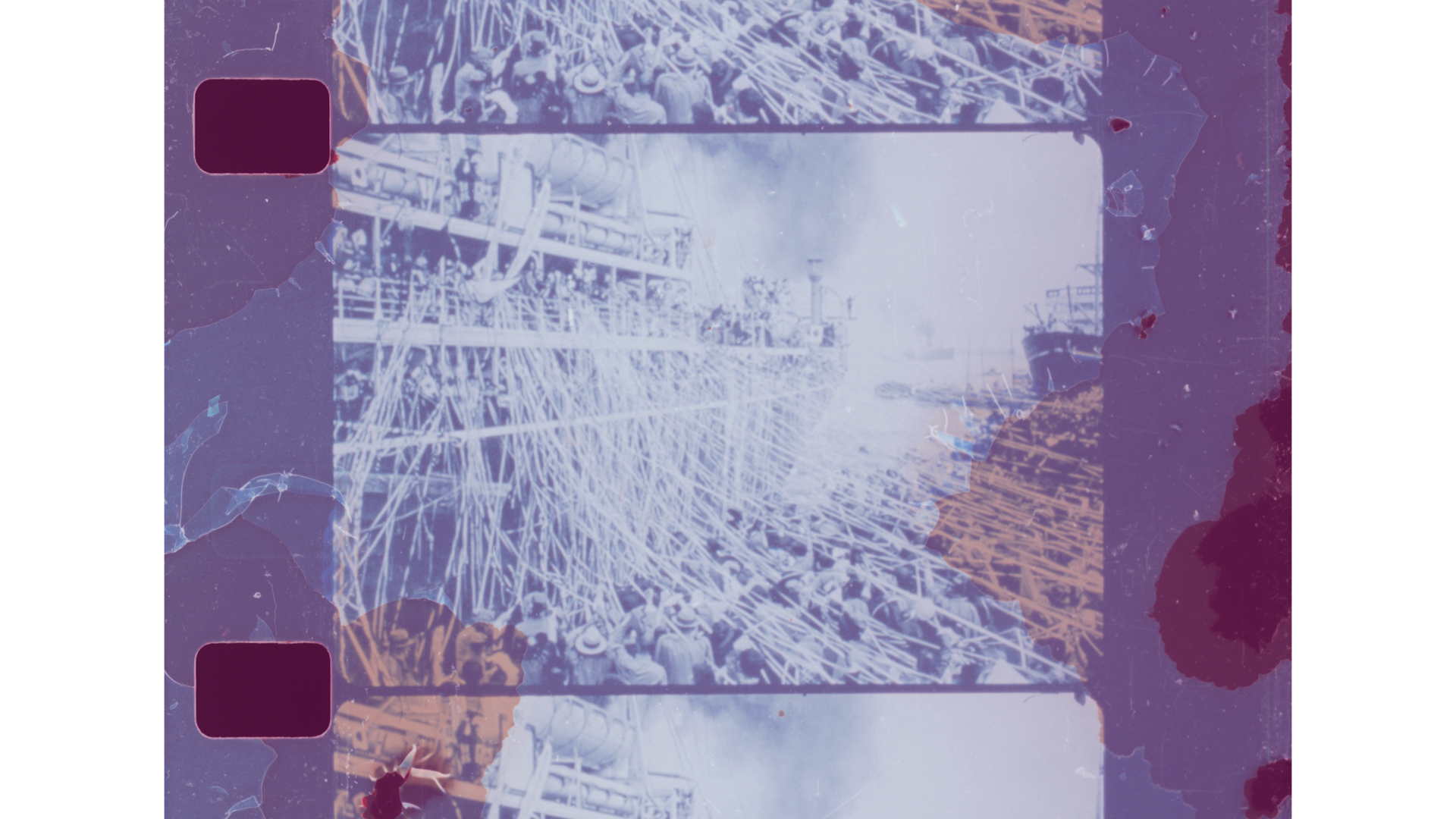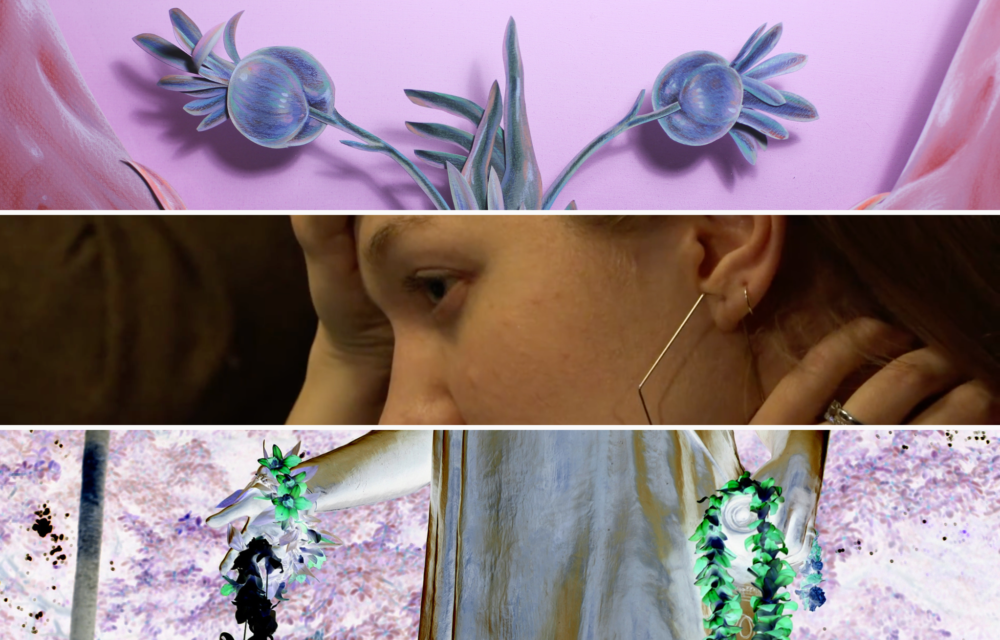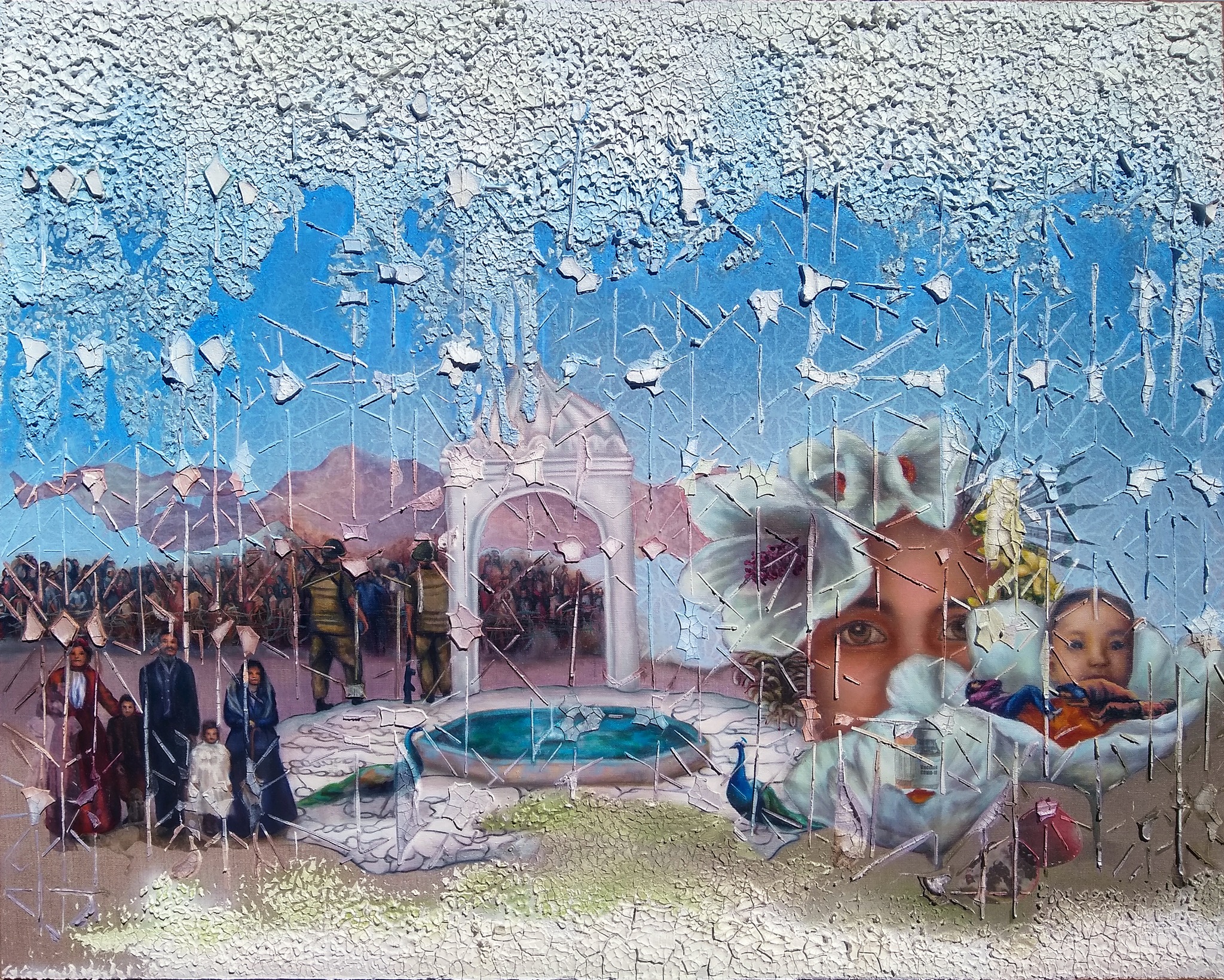News
Group Exhibition
Archive Fever
Accent Sisters
89 5th Ave #702, New York, NY 10002
T-F, 4-9pm
Sat-Sun, 2-9pm
November 21--December 5
Solo Exhibition
Maya Jeffereis: Land of Eternal Summer
International Studio and Curatorial Program
1040 Metropolitan Ave, Brooklyn, NY 11211
M-F, 10:30-5:30
Through February 20, 2026
Follow the link

Past
Film Screening
Colonial Currents: Six Short Films
The 8th Floor
17 West 17th Street, New York, NY 10011
Thursday, October 24, 6-8pm
Follow the link

The fourth season of Sight/Geist continues with a group screening of films by Vi Tuong Bui, Logan Lynette Burroughs, Lananh Chu, Mónica Félix, Daniel Pravit Fethke, and Maya Jeffereis. These six mediative and conversational works highlight colonial histories, bodily survival, and desires for familial connection. The screening will be followed by a discussion between the artists and Charles de Agustin, Programs and Engagement Manager at the Foundation.
All events are free and open to the public, with RSVPs requested. Scrawlspace is on view from 11am on the day of the program, with select works obstructed from 5:30pm due to the event setup. The screening will begin no later than 6:30pm. Info on accessing our space can be found here. Email us with any questions.
Program (56 minutes):
Lananh Chu, Poem for three voices, 2023
Vi Tuong Bui, Thời Thơ Ấu (Childhood), 2023
Daniel Pravit Fethke, Teak & Bricks, 2024
Mónica Félix, Pieza de conversación (Conversation Piece), 2023
Maya Jeffereis, Passages II, 2024
Logan Lynette Burroughs, to heaven, 2022
Film Screening
Brooklyn Artists Movie Marathon
Brooklyn Museum, Auditorium, 3rd Floor
Sunday, October 6, 12-1:30pm
Follow the link
Settle in for a collection of short films by Brooklyn filmmakers who submitted their work to The Brooklyn Artists Exhibition open call.
- 12–1:15 pm Alláfuera (or otherwise the United States) (Mónica Félix, 18 min.); Passages II (Maya Jeffereis, 11 min.); Objects of Heartbreak (Grace Kim, 9 min.); Fugue (Ali Newhard and Laine Rettmer, 11 min.); Las Nogas (Catya Plate, 20 min.)
- 1:30–2:30 pm Brincando el Charco: Portrait of a Puerto Rican (Frances Negrón-Muntaner, 55 min.), selected by Mónica Félix
- 3–4:45 pm An Oversimplification of Her Beauty (Terence Nance, 95 min.), selected by Grace Kim
Solo Exhibition
Aldrich Video Series: Maya Jeffereis
The Aldrich Contemporary Art Museum
258 Main Street, Ridgefield, CT 06877
September 30--October 20, 2024
Follow the link

Aldrich Video Series is a sequence of three solo presentations of video art. Each artist exemplifies a different approach to telling stories. Their distinct practices provide insights into the diverse methods at work in contemporary video art including improvisation, animation, and archival research.
Maya Jeffereis is an artist and filmmaker whose practice examines overlooked histories, weaving together narratives of resilience, solidarity, and rematriation. Fields Fallen from Distant Songs, 2023, builds upon the artist’s great-grandparents’ experience as Japanese sugarcane plantation workers in Hawai'i, while Passages II, 2024, surveys the political and cultural implications of Western expansion among islands in the Pacific and Caribbean.
Fields Fallen from Distant Songs, 2023, is centered on the artist’s great-grandparents’ experience as Japanese contracted laborers on Hawaiian sugarcane plantations during the early twentieth century. The film collapses time through the integration of archival footage of plantation workers, Jeffereis’ grandfather’s family videos from the 1960s, and her own documentation of the eruption of Hawaiʻi’s Kīlauea volcano in 2023. Throughout the film lines of contemporary Hawaiʻian poetry flutter across the frames, while an audio track of Japanese folk songs (holehole bushi) drifts over the visuals. The result is both a haunting reminder of a colonial past and a hopeful tribute to restoring relations with ancestral lands.
Taking a broadened perspective, Passages II, 2024, surveys the political and cultural implications of Western expansion amid Island territories such as Hawaiʻi, Guam, Puerto Rico, and the Philippines. Considering the islands’ shared history of US imperialism, the film emphasizes the ocean as a unifying force, joining together a collective legacy of resistance and understanding.
Maya Jeffereis was born in Los Angeles. She currently lives and works in New York, NY.
Maya Jeffereis' presentation is curated by Caitlin Monachino, Curatorial and Publications Manager.
Group ExhibitionMaya Jeffereis is an artist and filmmaker whose practice examines overlooked histories, weaving together narratives of resilience, solidarity, and rematriation. Fields Fallen from Distant Songs, 2023, builds upon the artist’s great-grandparents’ experience as Japanese sugarcane plantation workers in Hawai'i, while Passages II, 2024, surveys the political and cultural implications of Western expansion among islands in the Pacific and Caribbean.
Fields Fallen from Distant Songs, 2023, is centered on the artist’s great-grandparents’ experience as Japanese contracted laborers on Hawaiian sugarcane plantations during the early twentieth century. The film collapses time through the integration of archival footage of plantation workers, Jeffereis’ grandfather’s family videos from the 1960s, and her own documentation of the eruption of Hawaiʻi’s Kīlauea volcano in 2023. Throughout the film lines of contemporary Hawaiʻian poetry flutter across the frames, while an audio track of Japanese folk songs (holehole bushi) drifts over the visuals. The result is both a haunting reminder of a colonial past and a hopeful tribute to restoring relations with ancestral lands.
Taking a broadened perspective, Passages II, 2024, surveys the political and cultural implications of Western expansion amid Island territories such as Hawaiʻi, Guam, Puerto Rico, and the Philippines. Considering the islands’ shared history of US imperialism, the film emphasizes the ocean as a unifying force, joining together a collective legacy of resistance and understanding.
Maya Jeffereis was born in Los Angeles. She currently lives and works in New York, NY.
Maya Jeffereis' presentation is curated by Caitlin Monachino, Curatorial and Publications Manager.
Hānau Ka Moʻolelo
Donkey Mill Art Center
78-6670 Mamalahoa Hwy,
Holualoa, HI 96725
September 28--December 14, 2024Follow the link

Moʻolelo, n., Story, tale, myth, history, tradition, literature, legend, journal, log, yarn, fable, essay, chronicle, record, article; (From moʻo ʻōlelo, succession of talk; all stories were oral, not written.); A continuous or connected narrative; a history, a tradition.
The exhibition, Hānau Ka Moʻolelo, focuses on the transformative power of moʻolelo and presents these stories, traditions, histories and remembrances as evidence of collective and individual experiences and unfolding memories. Filled with kaona and layered meanings, artworks become the vehicle through which moʻolelo manifest–artists thoughtfully revealing stories and histories they have witnessed, researched, and/or remembered. With many of the artists gathering moʻolelo through oral history interviews with their own ‘ohana, artworks reveal their family histories and genealogical connections anchoring them to the past, present and the future.
When shared and received, moʻolelo offer clarity and a better understanding of the past, who we are and how we perceive the world around us. With the potential to inspire laughter and tears alike, moʻolelo are transformative catalysts of healing. Stories have the power to place us “there” in that moment where we can cross boundaries of place and time. Through this sharing, we bear witness to the wisdom and mana of that past that can continue to nourish and feed us today.
What can be learned from the stories shared with us by family, loved ones and strangers? How might our perceptions and understanding of these stories change over time? How is intergenerational knowledge shared (and withheld) today? What goes into the work of listening, remembering and amplifying? What kuleana (responsibilities and privileges) emerge from this transference of energy?
The Mill’s 2024 Artist-in-Residence, Seattle-based artist, Michelle Kumata, will lead a week-long Young Artist Residency Program for teens during which they will create artworks inspired by stories collected through interviews with elders and family members. This process encourages participants to explore their identity, family lore and heritage.
Participating Artists: Melissa Chimera, Maya Jeffereis, Michelle Kumata, Brandy Nālani McDougall, Adele Ne Jame, Harinani Orme, Nainoa RosehillFilm Program: The Earth We Breathe
The Isamu Noguchi Foundation and Garden Museum9-01 33rd Road (at Vernon Boulevard) Long Island City, New York 11106
Sunday, July 21, 20244 pm–5:30 pm
$16 general / free for members
Follow the link
In conjunction with the exhibition Toshiko Takaezu: Worlds Within, visitors are invited to a film program in the Education Studio (Level C) featuring five filmmakers from across Hawaiʻi, Okinawa, and the Japanese Hawaiʻian diaspora. These experimental non-fiction and narrative short films contemplate the complexities around land, belonging, and occupation across oceanic expanses, generations, and histories and expand upon the themes of earth, body, sound, and spirituality. The 60-minute screening of short films will be followed by a 30-minute discussion and Q&A with Curator Kate Wiener and artist Maya Jeffereis. The program fee includes admission to the Museum.
Leilehua Lanzilotti is a Kanaka Maoli composer, multimedia artist, and curator whose practice explores radical indigenous contemporaneity, integrating community engagement into the heart of projects. By world-building through multimedia installation works and nontraditional concert experiences/musical interventions, Lanzilotti’s works activate imagination around new paths forward in language sovereignty, water sovereignty, land stewardship, and respect. Uplifting others by crafting projects that support both local communities and economy, the work inspires hope to continue. leilehualanzilotti.com
Yu-Me (1972) is a dream-like artist film and unconventional self-portrait through a visual journey across the surface of Takaezu’s earthenware pot, resembling an aerial survey over vast landscapes.
Toshiko Takaezu (1922–2011) was instrumental in the post-war reconceptualization of ceramics from the functional craft tradition to the realm of fine art. Following the utilitarian vessels and pots of her early years, the artist progressively abstracted her forms to arrive at her signature rounded, closed form. The enclosed space—as metaphor for the human spirit, or as an evocation of its own micro universe—is unseen yet still has a powerful and mysterious presence. Today, her home and studio, established in 1975 in Quakertown, New Jersey is preserved as the Toshiko Takaezu Studio and continues to be used as a creative workplace by students and artists alike.
Mud Man (2017) tells a story of a community visited by bird droppings falling from the sky like clumps of mud, weaving together sound, memory, and inheritance with questions of autonomy, sovereignty, and occupation.
Chikako Yamashiro, Mud Man, 2017, 26 minutes
Mud Man (2017) tells a story of a community visited by bird droppings falling from the sky like clumps of mud, weaving together sound, memory, and inheritance with questions of autonomy, sovereignty, and occupation.
Chikako Yamashiro engages with political and social histories of Okinawa to create haunting works drawing on oral accounts. Her work reveals lesser-known aspects of Okinawa’s contemporary reality, while questioning dominant historical accounts of Japanese and American occupation of the islands. The site of fierce battles between the United States and Japan at the end of World War II, Okinawa still has a high concentration of American military bases, occupying around twenty percent of the land—despite the wish of many of its natives. Yamashiro’s work spans performance, filmmaking and photography, employing bodies as vehicles through which to carry stories from marginalized voices, bodies and souls from Okinawa, through uniquely poetic imaginings.
Fields Fallen from Distant Songs (2023) brings together archival images of colonial Hawaiʻi with hole hole bushi songs sung by Japanese immigrant sugarcane plantation workers to consider the legacies of extraction, migration, and displacement.
Maya Jeffereis, Fields Fallen from Distant Songs, 2023, 11 minutes Fields Fallen from Distant Songs (2023) brings together archival images of colonial Hawaiʻi with hole hole bushi songs sung by Japanese immigrant sugarcane plantation workers to consider the legacies of extraction, migration, and displacement.
Maya Jeffereis is an artist and filmmaker whose work in video, performance, and installation seeks to expand upon overlooked histories and fill in archival gaps with counter narratives, personal histories, and speculative fictions. Jeffereis’s work has been presented in the United States and internationally, including the Hirshhorn Museum and Sculpture Garden, Brooklyn Museum, and Queens Museum, among other institutions. She teaches art, art history, and Asian American Studies at Parsons School of Design at The New School and Hunter College (CUNY). She earned an MFA from Hunter College and BA and BFA from the University of Washington. mayajeffereis.com
LĀHAINĀ NOON (2014) merges sun, shadow, and unconscious desires during the solar phenomenon of Lahaina Noon when a person’s shadow disappears.
Christopher Kahunahana, LĀHAINĀ NOON, 2014, 15 minutes
LĀHAINĀ NOON (2014) merges sun, shadow, and unconscious desires during the solar phenomenon of Lahaina Noon when a person’s shadow disappears.
Chris Kahunahana is an award-winning Hawaiian filmmaker and Sundance Institute Feature Film and Native Lab Alumni. He is the writer, producer, and director of WAIKIKI, which has been recognized with multiple awards including a Grand Jury Award for Best US Narrative Feature at The Los Angeles Asian Pacific Film Festival, Best Feature Grand Prize at Flickers Rhode Island International Film Festival, and Best Made in Hawaii Feature Film at the Hawaii International Film Festival. His 360° film PIKO was exhibited in the Honolulu Museum of Arts, Artist of Hawaiʻi 2021, and his multimedia installation HULI was shown at the Heard Museum, Arizona, 2023. He also directed “A Day in the Life,” a short documentary for the Smithsonian Institute’s Asian Pacific American project, and is currently writing AIMAN, a near-future sci-fi centered on Oceanic climate refugees, and is attached to direct a major motion picture.